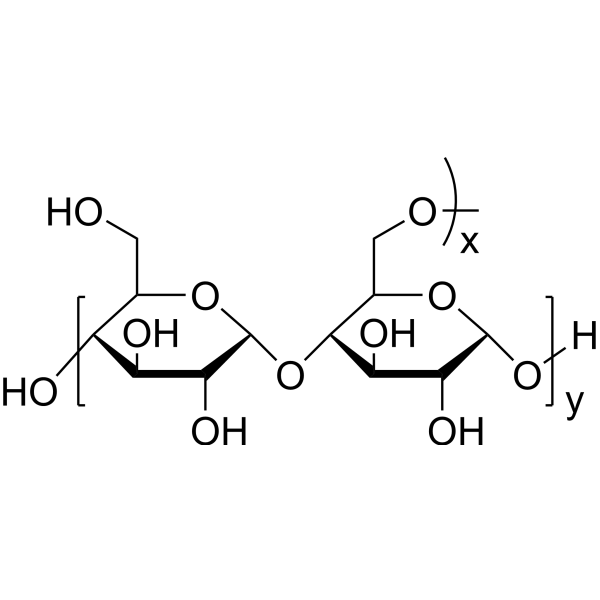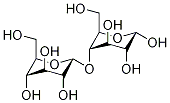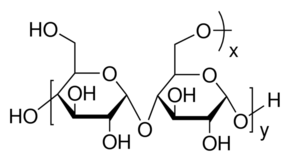麦芽糖糊精, AR,Maltodextrin
产品编号:西域试剂-WR338615| CAS NO:9050-36-6| MDL NO:MFCD00146679| 分子式:(C6H10O5)n·xH2O| 分子量:180.156
麦芽糊精,葡萄糖当量16.5-19.5可用作赋形剂。药用辅料,或称药用辅料,是指除药物成分外,在制药过程中使用的其他化学物质。药用辅料一般是指药物制剂中的非活性成分,可以提高药物制剂的稳定性、溶解性和加工性。药用赋形剂还影响共同给药药物的吸收、分布、代谢和消除(ADME)过程。
本网站销售的所有产品仅用于工业应用或者科学研究等非医疗目的,不可用于人类或动物的临床诊断或者治疗,非药用,非食用,
| 英文名称 | Maltodextrin |
|---|---|
| CAS编号 | 9050-36-6 |
| 产品描述 | 麦芽糊精,葡萄糖当量16.5-19.5可用作赋形剂。药用辅料,或称药用辅料,是指除药物成分外,在制药过程中使用的其他化学物质。药用辅料一般是指药物制剂中的非活性成分,可以提高药物制剂的稳定性、溶解性和加工性。药用赋形剂还影响共同给药药物的吸收、分布、代谢和消除(ADME)过程。 |
| 产品熔点 | 240ºC (dec.) |
| 产品沸点 | 527.1±50.0 °C at 760 mmHg |
| 产品密度 | 1.6±0.1 g/cm3 |
| 产品闪点 | 286.7±26.6 °C |
| 精确质量 | 180.063385 |
| PSA | 118.22000 |
| LogP | -3.17 |
| 外观性状 | 黄色粉末 |
| 蒸气压 | 0.0±3.1 mmHg at 25°C |
| 折射率 | 1.573 |
| 溶解性 | H2O: 0.1 g/mL hot, complete, yellow to very deep yellow |
| 溶解性数据 | 来源于玉米淀粉,麦芽糊精是一种糖类聚合物,可归类为碳水化合物。它可以通过酶或酸水解淀粉来生产。纯化和喷雾干燥后形成的材料可用于各种食品和饮料产品。它可以用作食品中的良好能源(16 kJ/g)。 Maltodextrin is a saccharide polymer that can be classified as a carbohydrate. It can be produced by enzymatic or acid hydrolysis of the starch. The material formed after purification and spray drying can be used in a variety of food and beverage products. It can be used as a good source of energy (16 kJ/g) in food products. |
| 靶点 |
Human Endogenous Metabolite |
| 稳定性 | 常温常压下稳定,避免强氧化剂 |
| 储存条件 | 密闭,阴凉干燥处保存 |
相关文档
化学品安全说明书(MSDS)
下载MSDS质检证书(COA)
相关产品
| 个人防护装备 | Eyeshields;Gloves;type N95 (US);type P1 (EN143) respirator filter |
|---|---|
| 安全声明 (欧洲) | S24/25 |
| 危险品运输编码 | NONH for all modes of transport |
| WGK德国 | 3 |
| RTECS号 | HH9450000 |
| 海关编码 | 3505100000 |
|
Section 1. Chemical Product and Company Identification Maltodextrin Common Name/ Trade Name Manufacturer Commercial Name(s) Synonym
Chemical Name Chemical Family Maltodextrin Section 4. First Aid Measures Eye ContactCheck for and remove any contact lenses. In case of contact, immediately flush eyes with plenty of water for at least 15 minutes. Cold water may be used. Get medical attention if irritation occurs. Skin ContactWash with soap and water. Cover the irritated skin with an emollient. Get medical attention if irritation develops. Cold water may be used. Serious Skin ContactNot available. InhalationIf inhaled, remove to fresh air. If not breathing, give artificial respiration. If breathing is difficult, give oxygen. Get medical attention. Serious InhalationNot available. IngestionDo NOT induce vomiting unless directed to do so by medical personnel. Never give anything by mouth to an unconscious person. If large quantities of this material are swallowed, call a physician immediately. Loosen tight clothing such as a collar, tie, belt or waistband. Serious IngestionNot available. Section 5. Fire and Explosion Data Flammability of the Product May be combustible at high temperature. Auto-Ignition Temperature Not available. Flash PointsNot available. Flammable LimitsNot available. Products of CombustionThese products are carbon oxides (CO, CO2). Fire Hazards in Presence of Slightly flammable to flammable in presence of heat. Various Substances Explosion Hazards in Presence Risks of explosion of the product in presence of mechanical impact: Not available. of Various SubstancesRisks of explosion of the product in presence of static discharge: Not available. Fire Fighting MediaSMALL FIRE: Use DRY chemical powder. and InstructionsLARGE FIRE: Use water spray, fog or foam. Do not use water jet. Special Remarks onAs with most organic solids, fire is possible at elevated temperatures Material in powder form, capable of Fire Hazardscreating a dust explosion. Special Remarks on Explosion Fine dust dispersed in air in sufficient concentrations, and in the presence of an ignition source is a potential Hazardsdust explosion hazard. Section 6. Accidental Release Measures Small SpillUse appropriate tools to put the spilled solid in a convenient waste disposal container. Finish cleaning by spreading water on the contaminated surface and dispose of according to local and regional authority requirements. Large SpillUse a shovel to put the material into a convenient waste disposal container. Finish cleaning by spreading water on the contaminated surface and allow to evacuate through the sanitary system. Be careful that the product is not present at a concentration level above TLV. Check TLV on the MSDS and with local authorities. Maltodextrin Section 7. Handling and Storage PrecautionsKeep away from heat. Keep away from sources of ignition. Ground all equipment containing material. Do not breathe dust. Keep away from incompatibles such as oxidizing agents. StorageKeep container tightly closed. Keep container in a cool, well-ventilated area. Section 8. Exposure Controls/Personal Protection Engineering ControlsUse process enclosures, local exhaust ventilation, or other engineering controls to keep airborne levels below recommended exposure limits. If user operations generate dust, fume or mist, use ventilation to keep exposure to airborne contaminants below the exposure limit. Personal ProtectionSafety glasses. Lab coat. Dust respirator. Use a dust respirator if ventilation is inadequate or handling of material creates visible dust clouds, and airborne concentrations exceed the recommended exposure limits. Be sure to use an approved/certified respirator or equivalent. Gloves. Personal Protection in Case of Splash goggles. Full suit. Dust respirator. Boots. Gloves. A self contained breathing apparatus should be a Large Spillused to avoid inhalation of the product. Suggested protective clothing might not be sufficient; consult a specialist BEFORE handling this product. Exposure LimitsFor Particulates Not Otherwise Specified: TWA: 10 (mg/m3) from ACGIH (TLV) [United States] TWA: 15 (mg/m3) from OSHA (PEL) [United States] Consult local authorities for acceptable exposure limits. Section 9. Physical and Chemical Properties Physical state and appearance Solid. (Powdered solid. Granular solid.)Odorless. Odor TasteNot available. Molecular WeightNot available. ColorWhite. pH (1% soln/water)Not available. Boiling PointNot available. Melting Point240°C (464°F) Critical TemperatureNot available. Specific GravityNot available. Vapor PressureNot applicable. Not available. Vapor Density VolatilityNot available. Odor ThresholdNot available. Water/Oil Dist. Coeff.Not available. Ionicity (in Water)Not available. See solubility in water. Dispersion Properties SolubilityEasily soluble in cold water, hot water. Section 10. Stability and Reactivity Data StabilityThe product is stable. Instability TemperatureNot available. Conditions of InstabilityExcess heat, incompatible materials, dust generation. Reactive with oxidizing agents. Incompatibility with various substances CorrosivityNon-corrosive in presence of glass. Maltodextrin Special Remarks onNot available. Reactivity Special Remarks onNot available. Corrosivity PolymerizationWill not occur. Section 11. Toxicological Information Routes of EntryInhalation. Ingestion. Toxicity to AnimalsLD50: Not available. LC50: Not available. Chronic Effects on Humans Not available. Other Toxic Effects onSlightly hazardous in case of skin contact (irritant), of ingestion, of inhalation. Humans Special Remarks onNot available. Toxicity to Animals Special Remarks onNot available. Chronic Effects on Humans Special Remarks on otherAcute Potential Health Effects: Toxic Effects on HumansSkin: Low hazard. May cause skin irritation by mechanical action. Eyes: Low hazard. Dust may cause eye irritation by mechanical action. Inhalation: Low hazard. Inhalation of dust may cause respiratory tract irritation by mechanical action. Ingestion: Expected low hazard. Section 12. Ecological Information EcotoxicityNot available. BOD5 and CODNot available. Possibly hazardous short term degradation products are not likely. However, long term degradation products Products of Biodegradation may arise. Toxicity of the ProductsThe product itself and its products of degradation are not toxic. of Biodegradation Not available. Special Remarks on the Products of Biodegradation Section 13. Disposal Considerations Waste DisposalWaste must be disposed of in accordance with federal, state and local environmental control regulations. Section 14. Transport Information DOT ClassificationNot a DOT controlled material (United States). IdentificationNot applicable. Special Provisions forNot applicable. Transport DOT (Pictograms) Maltodextrin Section 15. Other Regulatory Information and Pictograms TSCA 8(b) inventory: Maltodextrin Federal and State FDA: Direct Food Additives- GRAS list (21CFR 184) Regulations CaliforniaCalifornia prop. 65: This product contains the following ingredients for which the State of California has Proposition 65found to cause cancer which would require a warning under the statute: No products were found. Warnings California prop. 65: This product contains the following ingredients for which the State of California has found to cause birth defects which would require a warning under the statute: No products were found. Other RegulationsEINECS: This product is on the European Inventory of Existing Commercial Chemical Substances (EINECS No. 232-940-4). Canada: Listed on Canadian Domestic Substance List (DSL). China: Listed on National Inventory. Japan: Listed on National Inventory (ENCS). Korea: Listed on National Inventory (KECI). Philippines: Listed on National Inventory (PICCS). Australia: Listed on AICS. WHMIS (Canada) Not controlled under WHMIS (Canada). Other Classifications DSCL (EEC)This product is not classifiedNot applicable. according to the EU regulations. Health Hazard HMIS (U.S.A.)1 National Fire Protection 1 Flammability 1 Association (U.S.A.) Fire Hazard 1 0 Reactivity Health Reactivity 0 Specific hazard Personal Protection E WHMIS (Canada) (Pictograms) DSCL (Europe) (Pictograms) TDG (Canada) (Pictograms) ADR (Europe) (Pictograms) Protective Equipment Gloves. Lab coat. Dust respirator. Be sure to use an approved/certified respirator or equivalent. Maltodextrin SECTION 16 - ADDITIONAL INFORMATION N/A |
- 13. Muhammad, Zafarullah, et al. "Integration of polysaccharide-thermoprotectant formulations for microencapsulation of Lactobacillus plantarum, appraisal of survivability and physico-biochemical properties during storage of spray dried powders." Food hydrocol
- 12. Kiramat Ali Shah,高彬彬,李洁琼,崔京浩.丙二醇对利扎曲普坦普鲁兰多糖/麦芽糖糊精口腔速溶膜剂制剂学性质的影响[J].当代化工,2020,49(11):2379-2382.
- 11. 刘红波,徐思宁,唐志书,孙静,宋忠兴,崔春利,于金高,史鑫波,孙晓春.秦七风湿方凝胶基质组分优化与体外评价[J].中药新药与临床药理,2020,31(10):1233-1238.
- 10. 徐思宁,唐志书,刘红波,宋忠兴,王梅,孙静.基于QbD理念建立秦七风湿方提取液喷雾干燥工艺及其浸膏粉理化性质[J].中成药,2021,43(01):168-173.
- 9. 王亚雯 辛中豪 高蔚娜 蒲玲玲 石塔拉 姚站馨 袭著革 郭长江.不同碳水化合物升血糖作用的比较[J].解放军预防医学杂志 2017 35(09):1041-1043+1068.
- 8. 钱玲, 郑一文, 林影,等. 毕赤酵母表面展示麦芽三糖生成酶全细胞催化制备麦芽三糖[J]. 食品科技, 2020(5):1-7.
- 7. 杨鹏, 沈汪洋, 刘零怡,等. 油茶籽油微胶囊的制备及其品质分析[J]. 粮食与油脂, 2019.
- 6. 杨楠, 罗凡, 费学谦,等. 油茶籽中美拉德反应产物的抗氧化性及其含量分析[J]. 林业科学研究, 2019, 032(003):135-141.
- 5. 刘常园, 方东路, 汤静,等. 基于电子鼻和GC-IMS分析复热对香菇汤挥发性风味物质的影响[J]. 食品科学技术学报, 2020(4):46-53.
- 4. 刘素连, 张锐锐, 许有瑞. 罗汉果复合饮料泡腾片的研制[J]. 食品科技, 2020.
- 3. 孙道开, 范益芹. 添加不同辅料牛膝浸膏粉体表面特征与吸湿性的相关性[J]. 中成药, 2018, 040(002):326-330.
- 2. 朱宇超, 程建明, 颜媛媛,等. 基于混料设计的温经止痛方提取液喷雾干燥工艺研究[J]. 中国中药杂志, 2020, v.45(01):106-113.
- 1. 孙道开 范益芹.不同牛膝浸膏粉体表面特征与吸湿性的关系探索[J].中药材 2018 41(03):677-681.









 浙公网安备 33010802013016号
浙公网安备 33010802013016号